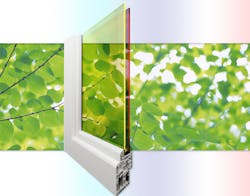Tandem quantum-dot luminescent solar concentrators power double-pane solar windows
Using two different types of quantum dots (QDs), researchers at the Los Alamos National Laboratory (Los Alamos, NM) are creating double-pane solar windows with luminescent solar concentrators that generate electricity with a solar-to-electrical power conversion efficiency of 3.1% while performing some shading as well; the double-paned structure also adds insulation.1
Each pane has its own QD layer; the two different QD layers are tuned to absorb different parts of the solar spectrum.
"Because of the the strong performance we can achieve with low-cost, solution-processable materials, these quantum-dot-based double-pane windows and even more complex luminescent solar concentrators offer a new way to bring down the cost of solar electricity," said lead researcher Victor Klimov. "The approach complements existing photovoltaic technology by adding high-efficiency sunlight collectors to existing solar panels or integrating them as semitransparent windows into a building’s architecture."
RELATED: Adding luminescent solar concentrators atop greenhouses doesn't hurt plant growth
The key to this advance is solar-spectrum splitting, which allows higher- and lower-energy solar photons to be spearately processed. The higher-energy photons can generate a higher photovoltage, which could boost the overall power output. This approach also improves the photocurrent as the QDs used in the front layer are virtually reabsorption free.
To achieve this, the Los Alamos team incorporates into QDs manganese ions that serve as highly emissive impurities. Light absorbed by the QDs activates these impurities. Following activation, the manganese ions emit light at energies below the QD absorption onset. This trick allows for almost complete elimination of losses due to self-absorption by the QDs.
To transform a window into a tandem luminescent sunlight collector, the Los Alamos team deposits a layer of highly emissive manganese-doped QDs onto the surface of the front glass pane and a layer of copper indium selenide QDs onto the surface of the back pane. The front layer absorbs the blue and ultraviolet portions of the solar spectrum, while the rest of the spectrum is picked up by the bottom layer.
Following absorption, the dot re-emits a photon at a longer wavelength, and then the re-emitted light is guided by total internal reflection to the glass edges of the window. There, solar cells integrated into the window frame collect the light and convert it to electricty.
Project members include Kaifeng Wu (Director's Postdoctoral Fellow), Hongbo Li (Postdoctoral Research Associate, Victor I. Klimov (Laboratory Fellow, Project Leader).
The work was supported by the Center for Advanced Solar Photophysics (CASP), an Energy Frontier Research Centre funded by the U.S. Department of Energy, Office of Science, Basic Energy Sciences.
Source: http://www.lanl.gov/discover/news-release-archive/2018/January/0102-quantum-dots.php?source=newsroom
REFERENCE:
1. Kaifeng Wu et al., Nature Photonics (2018); doi: 10.1038/s41566-017-0070-7

John Wallace | Senior Technical Editor (1998-2022)
John Wallace was with Laser Focus World for nearly 25 years, retiring in late June 2022. He obtained a bachelor's degree in mechanical engineering and physics at Rutgers University and a master's in optical engineering at the University of Rochester. Before becoming an editor, John worked as an engineer at RCA, Exxon, Eastman Kodak, and GCA Corporation.
